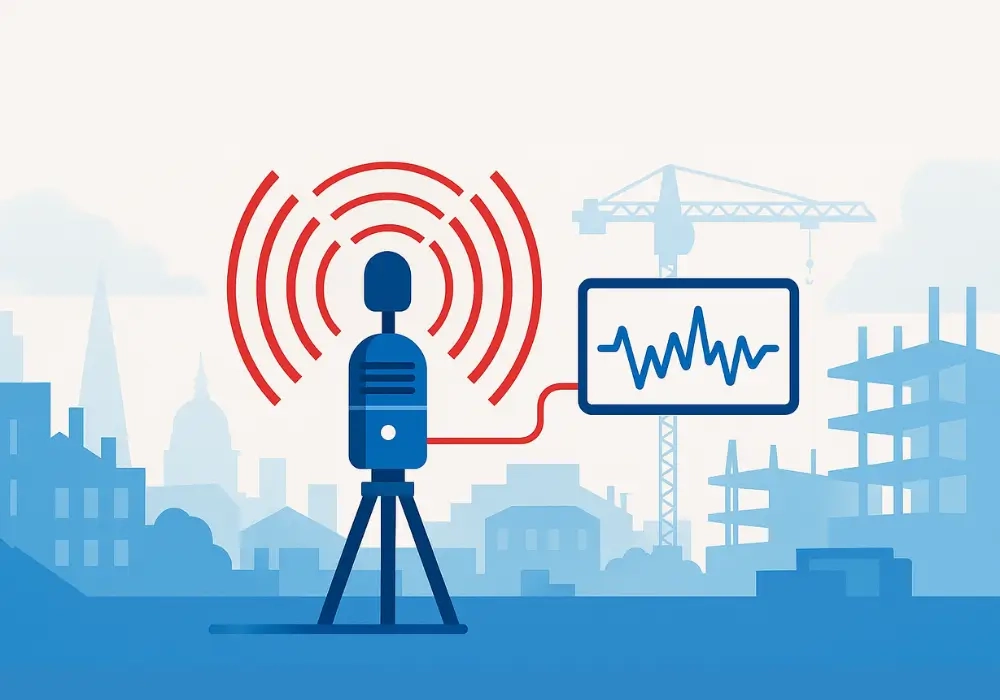Noise complaints can quickly add up to thousands of pounds in fines for construction companies. Recent surveys found that London, Leeds and Huddersfield are among the UK’s noisiest construction hotspots, each receiving around 600 public noise complaints every month. Under the Control of Pollution Act 1974 (CoPA), fines can reach up to £20,000 for every offence.
Compliance isn't optional, but the challenge is that manual noise checks can't catch sound breaches as they happen. Spot inspections often miss overnight work violations, and paper logs rarely stand up as credible evidence when councils investigate. By the time a problem is noticed, neighbours have usually already called environmental health officers.
Smart IoT-based workplace noise monitoring equipment offers a better solution. These integrated systems provide real-time data and instant alerts when noise levels approach Section 61 limits. This proactive approach helps site managers prevent excessive noise exposure, while automated time-stamped reports create a clear audit trail, reducing the risk of costly enforcement action.
In this article, we'll explain why noise monitoring matters, how it ensures compliance on UK construction sites and outline the regulatory frameworks that govern construction noise.
3 Reasons Why Environmental Noise Monitoring Matters in UK Construction
UK construction sites operate under some of the strictest regulatory compliance frameworks and noise regulations in the world. These rules are designed to protect workers, neighbouring communities and the surrounding environment.
Sections 60 and 61 of the Control of Pollution Act 1974 require contractors to obtain prior consent from their local council at least 28 days before starting any noisy construction or demolition work. This application must outline planned building activities, working hours and "Best Practical Means (BPM)" actions to reduce noise levels, dust and vibrations throughout the project.
Environmental health officers strictly enforce these conditions, with complaints triggering on-site workplace noise investigations that can delay or even suspend building works.
Without control measures and continuous environmental monitoring in place, site managers risk the following:
1. Fines and enforcement action
Local authorities can issue penalties for excessive noise. Section 61 violations can result in fines of £20,000, with repeated breaches increasing the cost even more. West-Tec Construction's near £28,000 fine for 12 noise violations in 2019 shows just how quickly costs stack up when multiple breaches occur.
On top of this, councils can also issue Noise Abatement Notices under Section 80 of the Environmental Protection Act (EPA) 1990 when noise becomes a "statutory nuisance", exceeding permitted limits of 87 dB(A). Failure to comply can lead to prosecution, more fines and possible project suspension.
2. Reputational damage and project delays
When residents or businesses complain about construction noise, it reflects poorly on your site, even if no technical breach has occurred. All directors see is badly managed community relations and weak project management in terms of ESG.
Repeated complaints indicate a lack of accountability and insufficient control, driving directors to question why noise issues weren't prevented through proper monitoring and noise control measures. Over time, these perceptions can damage your professional credibility.
When environmental health officers investigate, they can stop all construction activities until findings are confirmed. These inspections often delay projects and disrupt subcontractor schedules. On top of that, project delays may result in contractual penalties and cost overruns that eat into your profit margins.
Read more: How Smart Site Monitoring Protects Margins in Construction
3. Missing compliance documentation during audits
Under Section 61, construction site managers must keep workplace noise monitoring records for every project. Local councils value greener practices, and when they conduct compliance audits, they expect continuous monitoring logs, not one-off spot checks.
Manual logging using outdated or fragmented tools (like spreadsheets) can't keep pace with modern construction demands. These traditional methods are error-prone and rely on human input, creating compliance gaps when night shifts forget to record noise data or when weather conditions affect readings.
Plus, breaches of the Control of Noise at Work Regulations 2005 can result in substantial fines or legal action if construction companies fail to:
-
Manage workplace noise below the legal limits (such as the Exposure Limit Value of 87 dB(A))
-
Perform workplace noise assessments
-
Provide hearing protection and training for workers
Missing any documentation comes across as carelessness, even if no actual breach occurs. Automated noise monitoring equipment with in-built AI-video analytics that track, measure and timestamp every noise reading through a unified platform helps combat this, giving you a complete start-to-finish audit trail.
Read more:
- 7 Compliance Pitfalls Costing Construction Firm Millions
- GDPR, ESG and Construction: What Every Leader Needs To Know
Understanding UK Construction Noise Regulations
The first step to maintaining compliance is actually understanding what each regulation requires construction companies to do.
Let's break down 5 regulatory compliance standards in the UK construction industry:
-
Construction (Design and Management) CDM Regulations 2015: Requires employers to effectively manage workers' health, safety and welfare throughout construction phases. Contractors must assess noise risks and have control measures in place to mitigate risk while continuously monitoring site conditions at all times.
-
Section 61 of CoPA: This key legislation requires contractors to give at least 28 days' notice before starting any noisy building and/or demolition work. Applications must include the type of building activities, permitted working hours and control measures on how noise pollution will be managed and reduced.
-
Section 80 of the EPA and the Noise Act 1996: Both acts cover noise as a "statutory nuisance", allowing local authorities, under Section 80, to issue Noise Abatement Notices if loud noise, smoke and/or vibrations from construction works cause problems to neighbours or the surrounding areas.
-
British Standard BS 5228-1:2009 + A1 2014: This industry code of practice sets out guidance for industrial noise and vibration control measures on construction and open sites. It also advises construction companies to appoint a "responsible person to liaise with the public", ensuring nearby communities are informed about upcoming works and site teams are consistently briefed on effective noise control methods.
-
Local planning policies and HSE: Local planning permissions often provide specific requirements for noise control, permitted working hours and mitigation measures. Under the Health and Safety Executive (HSE), noisy construction work is allowed only between 08:00 and 18:00 on weekdays and 08:00 to 13:00 on Saturdays, with activities prohibited on Sundays and bank holidays.
3 Ways Noise Monitoring Ensures Compliance on Construction Sites
Let's take a closer look at 3 ways noise monitoring equipment keeps construction sites on the right side of UK law:
1. Real-time detection
Our Noise Monitoring Sensors, with remote monitoring capabilities, integrate smoothly with our CCTV Towers. Each system connects through our cloud-based Stellifii platform to deliver accurate, reliable and real-time acoustic data for temporary and mobile construction site environments.
Through Stellifii, each sensor provides smart analytical insights into noise levels across a wide frequency (20Hz to 12.5kHz) and decibel range (30-130dB), helping you:
-
Reduce noise exposure
-
Minimise the risk of "statutory nuisance" complaints
-
Protect surrounding communities
-
Demonstrate regulatory compliance with accessible data and automated reports
Unlike manual spot checks that only catch single-point readings, continuous monitoring shows noise patterns and highlights when levels approach Section 61 thresholds. Smart detection systems also monitor work zones to ensure workers are wearing the appropriate PPE equipment, like hearing protection and safety goggles, and send alerts to managers when these items are missing.
This level of real-time visibility enables site managers to take immediate corrective action. When sensors detect noise nearing pre-set limits or identify missing PPE, they automatically trigger on-site audio warnings and send time-stamped notifications to site managers, allowing for a quick response and traceable compliance reports.
Read more: Uses for IoT in Construction

2. Weather data improves accuracy
Weather conditions directly influence noise distribution: wind direction carries sound toward or away from sensors, temperature affects sound propagation and humidity levels impact absorption.
Our integrated environmental solutions combine noise sensors with weather monitoring to track wind speed (0–110mph), humidity (10-99%) and temperature (from -40°C to 60+°C) in real-time, providing more accurate noise monitoring readings with comprehensive data logging.
All sound level readings are stored and displayed using Stellifii alongside your CCTV footage. This allows site management teams to see the cause of a breach, review it on video and generate a complete compliance record all in one place. This not only supports inspections and internal audits but also protects your professional reputation as it demonstrates due diligence.
For instance, if the system logs excessive noise levels on a particularly windy day, you can check the footage to see why and how it happened with transparent evidence to back up your claims.
Read more: Weather Monitoring Tools That Keep Construction Projects on Track
3. Automated reporting
Stellifii makes compliance reporting easy by automating report logs in just a few clicks, delivering data exports up to 5X faster than legacy systems. This smooth procedure reduces admin workloads and takes the headaches out of pulling data from multiple systems just to stay compliant.
With Stellifii, every noise measurement is:
-
Recorded with precise timestamps and linked CCTV footage
-
Analysed using NDAA-compliant cameras and intelligent software
-
Stored securely in industry-approved cloud infrastructure with AES256 end-to-end encryption
You can download reports instantly to support planning conditions, stakeholder updates or enforcement investigations. Stellifii cuts admin time and provides 24/7 oversight over noise impact without the need for on-site checks. It's truly your "one-stop shop" for security, monitoring and compliance from a single interface that saves time, money and resources.
Read more: Stellifii: Our New Platform Transforming Surveillance, Safety & Compliance
5 Benefits of WCCTV's Environmental Noise Monitoring Services
Here are 5 advantages of our fully-managed environmental noise monitoring services:
-
Full compliance during audits: Detailed, time-stamped records through Stellifii ensure Section 61 and other ESG reporting requirements are met. When councils investigate noise complaints, you have quick access to exportable noise data showing continuous monitoring from start to finish.
-
Better community relations: Proactive environmental monitoring for noise and vibrations maintains positive neighbour relationships. When you detect and address excessive noise exposure issues before they turn into project-stopping complaints, you avoid damaging neighbours' trust and display social responsibility.
-
Reduced insurance costs: Insurers tend to favour environmentally responsible construction sites that use proactive monitoring and security measures. By using alternative powered noise monitoring systems, you show effective risk management, potentially helping to reduce your premiums and strengthen compliance.
-
Cost savings: Integrating workplace noise monitoring into your security plan can cut monitoring costs by nearly 88%. By consolidating data into one dashboard, you eliminate the need for multiple vendors and separate monitoring tools.
-
Peace of mind: With 24/7 remote monitoring, real-time alerts and automated reporting through Stellifii, you can rest assured your construction site remains compliant and protected at all times. Our fully-managed service means no manual checks and costly surprises; just consistent, reliable monitoring that keeps your projects on track.
Read more: Choosing a Monitoring Partner That Understands UK Construction
Futureproof Your Construction Site Today
Noise monitoring compliance on construction sites protects you from costly penalties and reputational damage.
When councils tighten enforcement under Section 61 and communities expect more responsible building practices, automated monitoring is the only way forward. Smart noise monitoring shows you're actively managing on-site risks and taking responsibility.
With 6 regional hubs and over 20-years of experience in wireless security and environmental monitoring, we know how serious non-compliance can be across the UK's construction sector. That's why we provide fully-managed, temporary workplace noise monitoring solutions to construction companies of any size.
Don't wait for compliance slips to put your projects at risk. Reach out to our monitoring experts today to find out how Stellifii can help keep you on the right side of UK law.
FAQs
What is noise monitoring compliance in the UK?
Noise monitoring compliance in the UK means staying within legally approved noise levels and following local regulations that protect workers and nearby communities. In a nutshell, it's about tracking, managing and documenting site noise to prove you're working responsibly.
What constitutes noise breaches in UK construction?
In the UK, noise breaches occur when construction sites violate noise regulations set to protect workers, residents and the environment, such as:
- Exceeding the Exposure Limit Value of around 87 dB(A)
- Working outside permitted hours (e.g., 08:00-18:00 on weekdays)
- Failing to comply with Sections 60 and 61 under the Control of Pollution Act 1974




